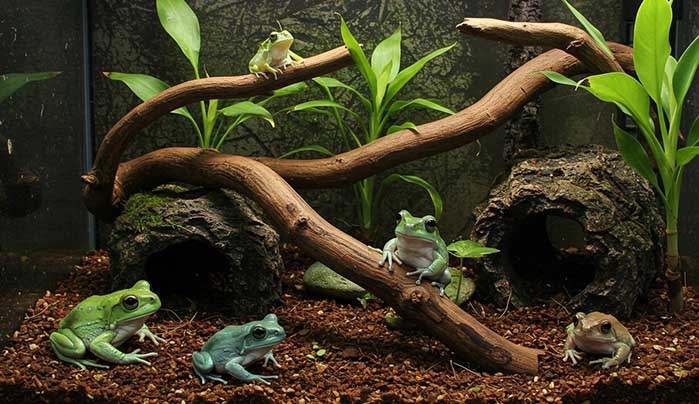Setting up the ideal habitat for your pet frog is the foundation of ensuring its health, longevity, and happiness. Frogs are diverse creatures, and their needs vary widely depending on the species. Some prefer a humid rainforest-style terrarium, while others need semi-aquatic environments or drier setups. Understanding your frog’s origins and mimicking its natural environment in captivity is the key to success.
This comprehensive guide will walk you through the essential steps to create a comfortable and naturalistic frog habitat, whether you’re caring for a tree frog, dart frog, or African clawed frog. By paying attention to factors like enclosure design, humidity, substrate, lighting, and enrichment, you can ensure your frog lives a happy and healthy life.
1. Research Your Frog Species
Before you begin building a habitat, it’s vital to research your specific frog species:
- Tree Frogs (e.g., White’s Tree Frog, Red-Eyed Tree Frog): Arboreal species that require vertical space, branches, and high humidity levels of 70–90%.
- Dart Frogs (e.g., Dendrobates, Phyllobates): Terrestrial, highly colorful frogs that thrive in bioactive, planted terrariums with 80–90% humidity.
- Aquatic Frogs (e.g., African Clawed Frogs, Dwarf Frogs): Need fully aquatic tanks with filtered, dechlorinated water.
Other frog types, such as toads or budgett’s frogs, may prefer semi-moist or semi-aquatic setups. Learn about your frog’s natural behavior, activity level, and environmental preferences before purchasing equipment.
2. Choose the Right Enclosure
The enclosure is the foundation of your habitat:
- Size: A single frog generally needs a 10- to 20-gallon tank. Larger species or multiple frogs require more space.
- Orientation: Vertical tanks for climbing species; horizontal tanks for terrestrial frogs.
- Material: Glass is popular for its visibility and humidity retention, but acrylic is lighter and less fragile.
- Ventilation: Essential to prevent mold and mildew. Choose enclosures with mesh tops or built-in airflow systems.
Secure lids are critical, as frogs are escape artists. Ensure any lid is tight-fitting and escape-proof.
3. Set Up the Substrate
Substrate contributes to humidity, comfort, and cleanliness:
- Tropical Frogs: Use coconut fiber, sphagnum moss, organic topsoil, or bioactive substrates with springtails and isopods.
- Semi-Aquatic Frogs: Include both land (soil or moss) and water sections with safe transitions.
- Aquatic Frogs: Smooth gravel or sand; avoid sharp or small pebbles that may be ingested.
For added realism, you can create layers of substrate with drainage (e.g., hydroballs or LECA) at the bottom, followed by mesh, soil, and moss.
4. Control Temperature and Humidity
Environmental stability is crucial for amphibians:
- Temperature Range: Most frogs thrive between 70–80°F. Use thermostatically controlled heat mats or lamps as needed.
- Humidity Levels: Vary by species, ranging from 50% (toads) to 90% (dart frogs).
- Tools: Install digital thermometers and hygrometers at both top and bottom of the tank to track variations.
Use hand misters, automatic misting systems, or foggers to maintain humidity. Avoid letting the tank become overly wet or stagnant.
5. Provide Hides, Climbing Features, and Enrichment
Frogs need hiding places and opportunities to express natural behaviors:
- Hides: Use coconut halves, cork bark, or commercial hides to provide security.
- Climbing Areas: Add driftwood, bamboo poles, or suction-cup ledges for tree frogs.
- Enrichment: Introduce safe live plants (e.g., pothos, bromeliads) to encourage exploration.
Live plants also help regulate humidity and improve air quality. Change the layout periodically to keep your frog stimulated.
6. Add a Water Source
Frogs depend on clean water for hydration and skin health:
- Terrestrial Species: Provide a shallow water bowl large enough for soaking.
- Semi-Aquatic Frogs: Divide the enclosure into land and water zones.
- Aquatic Frogs: Use a fully aquatic setup with a filtration system.
Always dechlorinate tap water using a safe conditioner. Replace water daily or as needed to prevent bacterial buildup.
7. Set Up Proper Lighting and Photoperiod
Frogs require a regular light-dark cycle:
- Lighting: Use LED or full-spectrum lights to simulate day and night (12 hours each).
- UVB Light: Beneficial for some species like tree frogs and dart frogs, though not always essential.
- Avoid: Direct, high-intensity lights that can dry out or stress your frog.
Use timers to automate lighting and help your frog maintain a consistent routine.
8. Maintain a Clean Environment
Cleanliness reduces stress and prevents infections:
- Daily Tasks: Spot clean waste, uneaten food, and cloudy water.
- Weekly Tasks: Wipe surfaces, rinse decor, and clean water bowls.
- Monthly Tasks: Change substrate (unless using a bioactive setup) and perform deep cleans.
Avoid harsh chemicals. Use reptile-safe or diluted vinegar solutions when disinfecting.
9. Monitor Behavior and Health
Observe your frog daily to catch early signs of stress or illness:
- Healthy Signs: Clear eyes, active movement, regular feeding, and smooth skin.
- Red Flags: Loss of appetite, lethargy, bloating, discoloration, or abnormal shedding.
Maintain a record of feeding, cleaning, and behavioral changes to share with your vet if issues arise.
10. Consider Bioactive Terrariums for Advanced Setups
A bioactive habitat includes live plants, beneficial microorganisms, and detritivores:
- Advantages: Low maintenance, naturalistic environment, and better humidity regulation.
- Components: Drainage layer, mesh screen, substrate mix, live plants, springtails, and isopods.
Bioactive enclosures are ideal for dart frogs and can be scaled for other terrestrial species. However, they require initial setup knowledge and occasional rebalancing.
The Benefits of a Suitable Habitat
Creating a proper frog habitat doesn’t need to be complicated, but it does require attention to detail, research, and consistency. Mimicking the natural environment of your frog’s native habitat helps reduce stress and improve overall well-being. Focus on habitat customization, cleanliness, and regular observation.
As you gain experience, you can explore more advanced systems and upgrade your setup with naturalistic or bioactive features. Always prioritize the specific needs of your frog species and provide enrichment that supports natural behavior. With dedication and proper care, your frog can thrive in a safe, engaging, and beautiful home.

